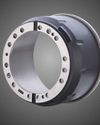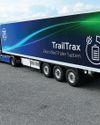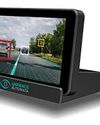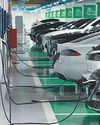
The objective of this article is to present new advanced testing procedures for regenerative braking. The two first parts of the article introduced the work and presented the methodology –test procedure, instrumentation, post-processing formulae, etc.– for the vehicles whose regenerative system was characterized in terms of durability and performance testing. The 3rd part focused on the results for the brake durabilities: Vehicle 1 completed a short Los Angeles City Traffic (LACT) test, while Vehicle 2 data was gathered across a Mojácar durability.
This 4th and last part, on the other hand, will present the main results for Vehicles 3 and 4, that were tested in IDIADA HQ's proving ground.
1. Performance Testing
1. Vehicle 3
The regenerative behaviour of the vehicle is highly tuneable due to the different selectable levels available through paddles behind the steering wheel Level 0 (no regeneration), Level 1, Level 2, Level 3 and i-Pedal (Single Pedal).
Brake blending is available in all levels except for the neutral gear and Level O which have the same strategy - no regeneration at all.
Coastdown deceleration (no brake pedal application) levels vary from 0,8m/ s2 of Level 1 to 2,3m/s2 of the i-Pedal mode.
The vehicle is not capable of controlling the wheel slip with the electric motors, hence the regeneration is always disconnected when a panic brake application is performed. Nevertheless, this disconnection is performed with a certain slope and keeping a certain amount of small regeneration in the "background" throughout the stop.
Denne historien er fra July 2024-utgaven av Auto Components India.
Start din 7-dagers gratis prøveperiode på Magzter GOLD for å få tilgang til tusenvis av utvalgte premiumhistorier og 9000+ magasiner og aviser.
Allerede abonnent ? Logg på
Denne historien er fra July 2024-utgaven av Auto Components India.
Start din 7-dagers gratis prøveperiode på Magzter GOLD for å få tilgang til tusenvis av utvalgte premiumhistorier og 9000+ magasiner og aviser.
Allerede abonnent? Logg på

U.S. COMMERCE DEPARTMENT ISSUES PRELIMINARY DECISION ON TURKISH BRAKE DRUM SUBSIDIES
On December 06, 2024, the U.S. Department of Commerce announced a preliminary affirmative determination in the Countervailing Duty (CVD) investigation concerning certain brake drums imported from the Republic of Türkiye as per The Brake Report.

BHARAT MOBILITY GLOBAL EXPO 2025 THE COMPONENTS SHOW PREVIEW
The Bharat Mobility Global Expo 2025, slated for January 17-22, is ready to dazzle the world with its expansive and innovative display of automotive and mobility solutions, writes Ashish Bhatia.

INTELLIGENT TRAILERS
Today's trailer customers enjoy access to a complete range of integrated solutions, writes Ashish Bhatia.

UNLOCKING THE POTENTIAL OF USED EVS IN INDIA'S GROWING EV MARKET
India's EV market, valued at USD 2 billion, is on the fast track to becoming the third largest globally by 2025. However, maintaining this momentum will depend heavily on developing a robust second-hand EV market

SAPIENCE HARNESSES AI FOR ROAD SAFETY
Sapience Automata is banking on Al-driven ADAS innovations to curb accidents, and improve fleet efficiency, writes Upendra Kasbekar.

TRAFFIC SURVEILLANCE SOLUTIONS
CP Plus is offering innovative traffic surveillance solutions to enhance on-road safety. writes Richa Tyagi.

LEGACY BRAND RENEWED PURPOSE
As Godrej Enterprises Group celebrates its 127th anniversary, the company unveiled a bold vision to chart a sustainable and innovative path forward, writes Ashish Bhatia.

GLOBAL AUTOMOTIVE SOLUTIONS
Raghavan Sampath, Director of Business Development, India Business Development Division at MediaTek, shared the company's strategic approach of offering global automotive solutions, with Richa Tyagi.

SOUTH KOREAN BATTERY MAKERS' DECLINING SHARE
Three South Korean electric vehicle battery makers saw their combined global market share fall from a year earlier in the first 10 months of 2024 amid robust growth of Chinese rivals, industry data showed on Monday.

UNO MINDA GPT-ENABLED MUSIC SYSTEM
Uno Minda Ltd. has introduced India’s first GPT-enabled Android music system, the WTUNES-464DN-GPT, revolutionizing the in-car experience.